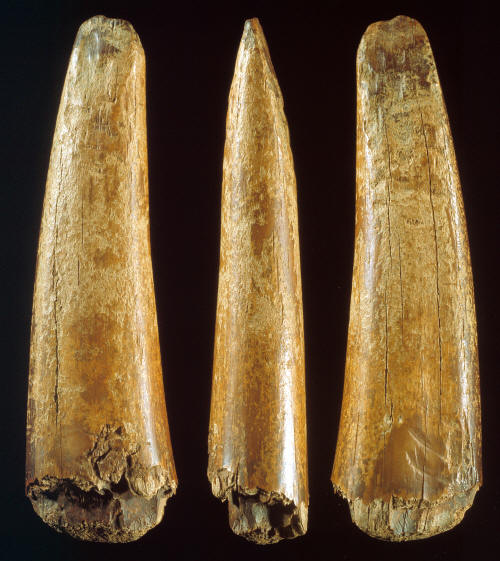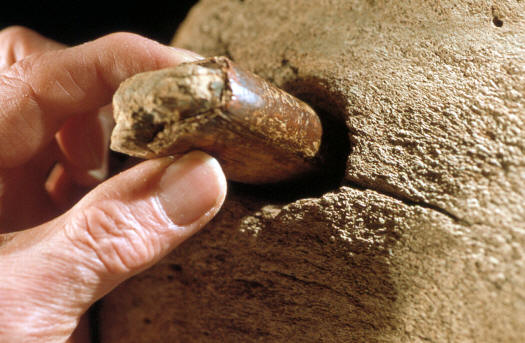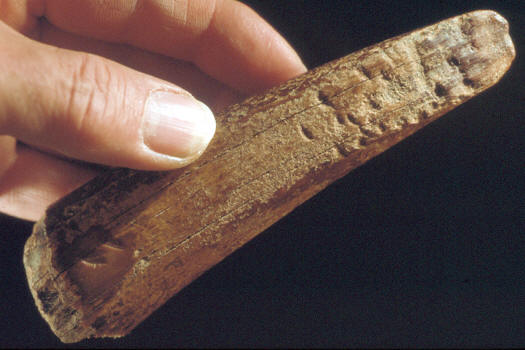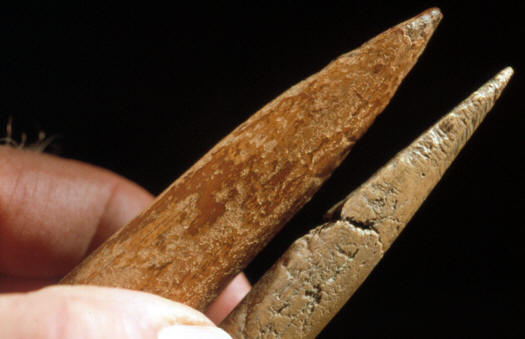|
"The point and bone (described
in this article) in which it is
embedded are some of the earliest direct evidence of pursuing large
whales."---2008,
Richard Michael Gramly, PhD.---Personal Communications.
"The sheer bulk of the bowhead threatened the
puny men who dared pursue it in their fragile boats."---1975,
William R. Hunt, "Arctic Passage," p. 118.
"At favorable locations in
Greenland, Labrador and northern Alaska, great whales were hunted by
crews from the large open skin boat, the umiak; the whale was repeatedly
harpooned, forced to drag lines to which were attached inflated bladders
of sealskin, until finally, exhausted, it was killed with a lance and
towed ashore and butchered amidst joyous ritual."---1987,
Don E. Dumond, "The Eskimos and Aleuts," p. 25.
"If the ice edge is
near, the bowhead sometimes dashes for the protection the ice offers.
Once the whale is under the ice, the hunters are thwarted. Even if they
have harpooned the bowhead, they must cut the line and allow it to
escape"---1975,
William R. Hunt, "Arctic Passage," p. 119.
"Russian
archaeologist Nikolai Most was sweeping up the floor of an ancient house
at (an ancient Old Whaling Culture
village) site when he uncovered a 20
inch long walrus tusk carved with a seal, a bear, and an unmistakable
image of people hunting a whale from a boat. The tusk dates to around
1000 B.C."---2008,
Eric A. Powell, "Origins Of Whaling, Chukotka Peninsula, Russia,"
Archaeology Mag., January/February, p. 27.

BOWHEAD WHALEBONE
WITH IMBEDDED
IVORY HARPOON
NORTH
AMERICA
SAINT LAWRENCE ISLAND
IN THE BERING SEA
2120 YEARS BEFORE PRESENT
Archaeological discoveries are made all the time and more-often-than-not
they come from people who are not scientists. In this case, the
discovery was made by Alaskan native Franklin Matchian. In the fall of
2002 or 03, he bought several pieces of whalebone from a wholesaler
located in the Wasilla area outside of Anchorage. They were collected on
the shore of St. Lawrence Island in the Bering Sea. Franklin is an
Alaskan artist who makes a living carving whalebone and walrus ivory.
His wife is a Yup'ik artist from Hooper Bay, Alaska. Between the two of
them, one of their specialties are Chevak dolls that have faces made of
walrus ivory and wear gut parkas.
|
|

BOWHEAD WHALEBONE
WITH TIP OF IVORY HARPOON
NORTH
AMERICA
SAINT LAWRENCE ISLAND
IN THE BERING SEA
2120 YEARS BEFORE PRESENT
PRIVATE
COLLECTION
This bone segment of a bowhead whale's flipper was collected several
years ago on the shore of Saint Lawrence Island in the Bering Sea.
The object in the hand is the broken tip of a Walrus ivory harpoon
or lance
that was found deeply imbedded in the bone. The ivory harpoon or
lance tip measures 4 3/4 inches (12 cm) long and 1 9/16 inches (4
cm) wide at the broken end. The whalebone measures slightly over 7
inches (18 cm) across in the x-ray. |
|
|
Franklin made
the discovery while preparing to carve one of the bones for the Alaska
Federation of Natives Show in late October of 2007. He noticed a defect
sticking up like a barnacle that impeded the carving of a polar bear or
whale figure. Franklin writes that, "I started wiggling the object until
after a few hard pushes and pulls, out came the ivory. It was wedged in
by three or four tiny rocks, holding the ivory in place". The object was
made of fossil walrus ivory and identified as the broken end of a large harpoon. Another year went by
before the bone was identified as a bowhead whale's flipper. |
|

BOWHEAD WHALE
EASTERN &
WESTERN ARCTIC SEAS
Bowhead whales are believed to be the world's oldest living mammals.
They may live to as much as 211 years or more. Estimates of age have
been calculated by measuring changes in levels of aspartic acid in
teeth and the lenses of eyes.
Up until 2001 whale hunters have recovered at least six old
harpoon points from bowhead whales. The more recent examples are
represented by metal
blades. The earlier harpoons had slate blades and
one example had a flaked stone point. The broken tip of the walrus ivory harpoon described
in this article was found imbedded in a bone segment from a bowhead
whale's flipper.
Bowhead whales are still hunted by northern Inupiaq and Yupik
hunters. Julius Alowa, an Eskimo from Savoonga on St. Lawrence
Island killed a bowhead whale this year on Thanksgiving day that
measured 65 feet long and weighed 65 tons.
Bowhead whales exist in the northern regions of the Arctic
where they live on krill they strain out of the water through
hundreds of pounds of baleen. Their lack of a dorsal fin makes them
well suited for maneuvering under floating ice where their only
predator the Orcas dare not follow for fear of injuring their large
dorsal fins. |
|
|
There have been two
radiocarbon dates returned from samples taken from the harpoon and the
whalebone. The oldest date of 2120+/-40BP was received for the bone. The
sample from the ivory harpoon returned a date of 2050+/-40BP.
The radiocarbon dates and evidence of bone growth around the wound would support the idea
that the whale may have survived the attack and lived for many years afterwards.
But since the radiocarbon dates are so close together the main
determining factor for evidence of survival of the whale relies mainly
on the healing of the wound. |
|

CLICK ON PICTURE FOR LARGER IMAGE
BROKEN TIP OF A WALRUS
IVORY HARPOON
NORTH
AMERICA
SAINT LAWRENCE ISLAND
IN THE BERING SEA
2120 YEARS BEFORE PRESENT
PRIVATE
COLLECTION
This picture shows three views of the broken tip of the walrus ivory
harpoon. It was discovered deeply imbedded in a bone segment from
the flipper of a bowhead whale. This is a heavy duty projectile.
Most whale harpoons have metal or stone blades attached to the point.
An x-ray of the bone shows that this harpoon didn't have a cutting blade
attached to the point. The piercing end of this harpoon is flat and
squared and has no sharp cutting edge. The point was made by
trimming away two opposite sides to form a chisel tip. This uncommon
design was obviously very effective. It was deeply imbedded into the
bone. The ivory harpoon or lance tip measures 4 3/4 inches (12 cm)
long and 1 9/16 inches (4 cm) wide at the broken end. |
|
|
Archaeologist Mike Gramly comments about this artifact:
"Judging by the radiocarbon age of the walrus ivory point and its find
spot, St. Lawrence Island, south of the Bering Strait, it was
manufactured during the terminal phase of the Old Bering Sea culture (OB
Sea III 300-500 AD). The point and bone in which it is embedded are some
of the earliest direct evidence of pursuing large whales. According to Edmund Carpenter, "The Old Bering Sea
marked the first major florescence of the Eskimo way of life. Permanent
villages of log houses were occupied by families of hunters who had
developed the weapons and skills required to hunt large sea mammals,
walrus and whales..." (Upside/Down: Les Arctiques; exhibition catalogue
by Edmund Carpenter, Musee du Quai Branly, September, 2008). |
|

BOWHEAD WHALEBONE WITH
IMBEDDED IVORY HARPOON
SAINT LAWRENCE ISLAND
IN THE BERING SEA
2120 YEARS BEFORE PRESENT
PRIVATE
COLLECTION
This picture shows
the refitting of the harpoon back into the hole from which it was
discovered. The harpoon was broken off flush with the outside
surface of the bone. There appears to be some bone growth around the
wound. It's believed that the whale was not killed from this injury
and in fact may have lived many years after it was attacked. |
|
|
This harpoon is interesting for its uncommon design. Since it is broken
it's not possible to entirely identify it as a harpoon. It could also be
the point off a lance which is a spear that would have been used to kill
the whale after it was harpooned. Most whale harpoons were
fitted with either metal or stone blades. The earliest examples have
flaked stone points or blades made of slate. This harpoon has no sharp
cutting edge. The point was made by partially grinding two opposite
sides to form a chisel tip. An x-ray of the whalebone
indicates that there are no more pieces of the harpoon left in the bone.
The broken point of this ivory harpoon or lance tip measures 4 3/4
inches (12 cm) long and 1 9/16 inches (4 cm) wide at the broken
end. |
|

TIP OF WALRUS IVORY HARPOON
SAINT LAWRENCE ISLAND
IN THE BERING SEA
2120 YEARS BEFORE PRESENT
PRIVATE
COLLECTION
The
penetrating tip of this ivory harpoon or lance is shaped like a chisel. It
was formed by cutting away two opposite sides to form a flat chisel
like edge on the point. The tapered surfaces were not smoothed but
they are slightly pitted and roughened. It measures 4 3/4 inches (12
cm) long and 1 9/16 inches (4 cm) wide at the broken end. |
|
|
The earliest evidence for whale hunting was recently
discovered by
Russian archaeologist Nikolai Most. An engraving of a whaling scene was
found on a 20 inch long piece of walrus tusk. It was found during the
excavation of an ancient house floor belonging to the Old Whaling
Culture. The village site was discovered by archaeologist Sergei Gusev on
Russia's Chukotka Peninsula. The find represents the earliest
evidence for whaling and dates to 3,000 years before
present. |
|

TIP OF IVORY HARPOON &
EAST WENATCHEE BONE ROD
SAINT LAWRENCE ISLAND IN THE BERING SEA
&
THE EAST WENATCHEE CLOVIS SITE, WASHINGTON
This picture shows a comparison of two artifacts. The example to the
left is the harpoon or lance tip described in this article. The lower example is
one of the bone rods from the East Wenatchee Clovis site. Another
idea for the purpose of the 13 tapered ended bone rods found in the
cache at Wenatchee may be that they were used as a lance if they
were lashed together into one long staff. One of the chisel tipped
ends may have served as the lance's tip. |
|
|
The discovery of an imbedded harpoon or lance tip was an extraordinarily lucky
find. Whether this bowhead whale was lanced or harpooned, the healed
wound seems to show that the animal survived after it was attacked. The
radiocarbon dates also suggest that the whale may have lived as much as
70 more years. It is lucky that the ancient hunter was not able to retrieve
his weapon. It would seem that the flipper
shielded the animal at just the right moment. These old and weathered
pieces of ivory and bone are evidence of what must of been a fairly dramatic moment nearly 2,000 years ago. |
|
"REFERENCES"
1975,
Hunt, William R., "Arctic Passage," pp. 118-119.
1987,
Dumond, Don E., "The Eskimos and Aleuts," p. 25.
1985,
MacDonald, George F., "Debert, A Paleo-Indian Site In Central
Nova Scotia," p. 113.
2008, Powell, Eric A., "Origins Of Whaling, Chukotka
Peninsula, Russia," Archaeology Mag., January/February, p.
27.
2008, Carpenter, Edmund, "Upside/Down: Les Arctiques, Musee du
Quai Branly.
2008, Gramly, Richard Michael, Personal Communication
2008, Guerri, Elmer A. Personal Communication.
|
|
RECENT
LISTINGS HOME
ORDERING |